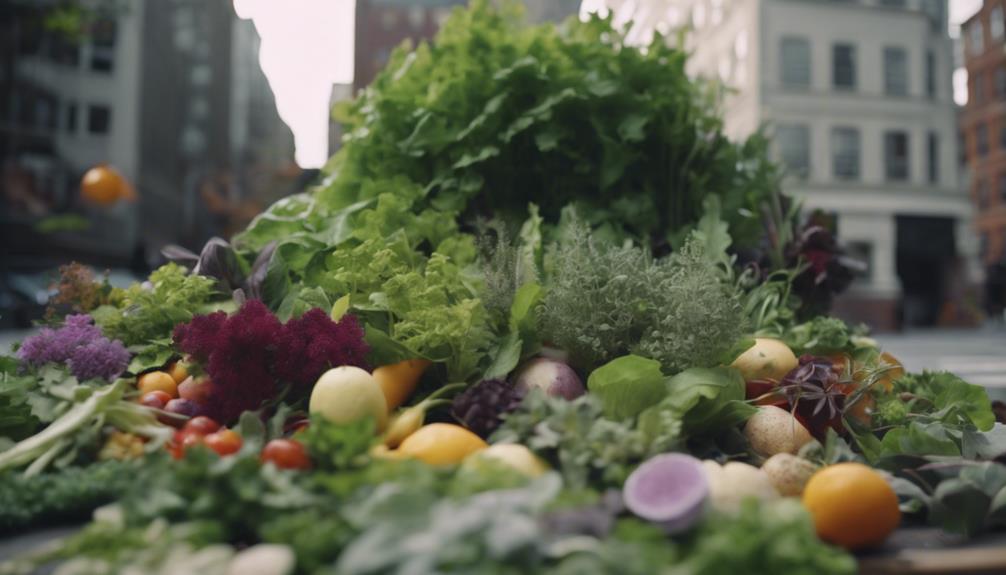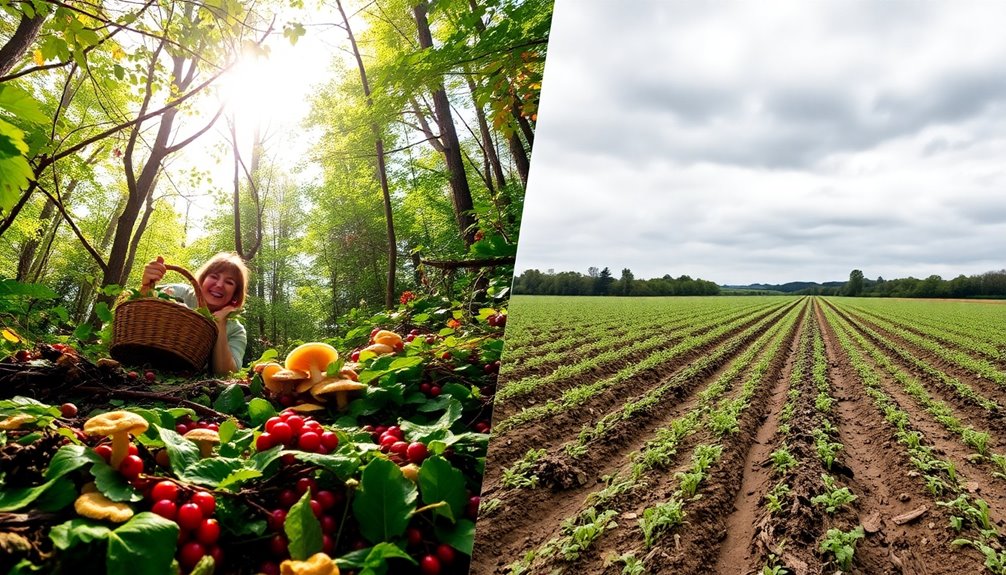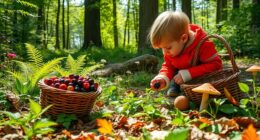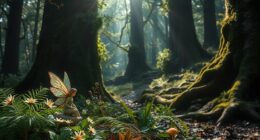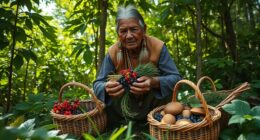Bees forage mainly during daylight hours, peaking in late morning to early afternoon. Their foraging aligns with seasonal changes; it ramps up in spring as flowers bloom and temperatures rise above 16°C (61°F). You'll notice the busiest times around late spring and early summer when resources are abundant. As fall approaches, foraging slows down as bees prepare for winter by gathering essential nectar. Environmental conditions like temperature and weather also influence their routines. Understanding these rhythms is vital for appreciating the complex world of bees, and there's more to uncover about their fascinating behaviors.
Key Takeaways
- Honey bees primarily forage during daylight hours, with peak activity in late morning to early afternoon on warm, sunny days above 16°C (61°F).
- Foraging activity increases in spring, peaks in late spring and early summer, then declines as floral resources diminish in late summer and fall.
- Environmental factors, such as temperature and weather conditions, significantly influence daily foraging routines and overall nectar availability.
- In fall, foraging shifts toward resource optimization for winter, coinciding with reduced brood rearing and dwindling floral resources.
- Approximately 250 bee species forage at night, utilizing adaptations for low-light conditions to gather resources when competition is lower.
Honey Bee Foraging Overview
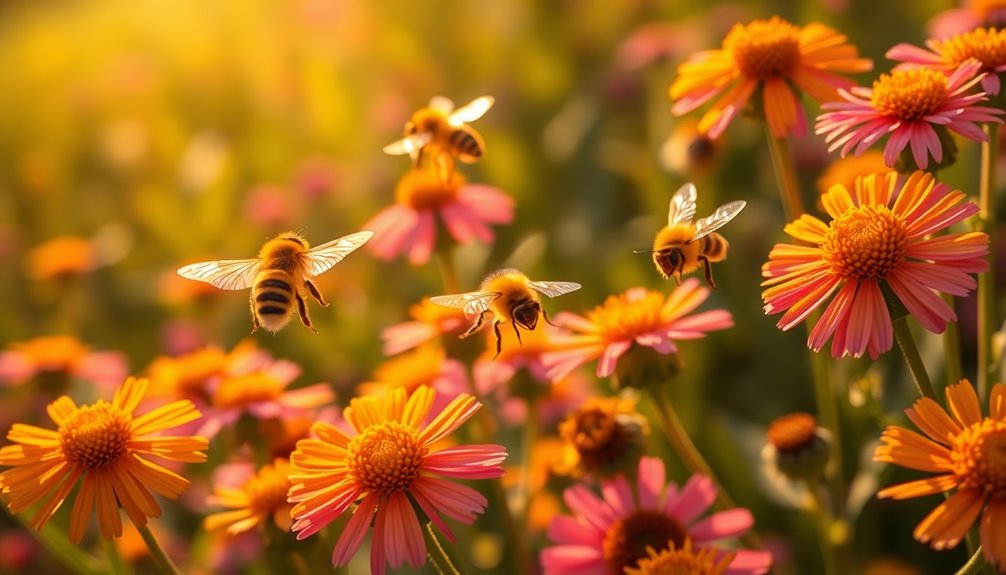
Honey bees are remarkable foragers, primarily active during daylight hours. You'll notice that their foraging activity peaks on warm, sunny days when temperatures exceed 16°C (61°F). As spring rolls in and floral resources become available, these bees get busy, continuing their foraging through summer. This period coincides with the colony's growth and brood rearing, making it vital for their survival.
Bees typically forage most actively during the late morning and early afternoon, capitalizing on ideal nectar flow and pollen availability. The bloom times of local plants dictate how much food is available, requiring bees to adapt their foraging strategies accordingly. You might observe them adjusting their activity based on circadian rhythms, responding to changes in light conditions and temperature fluctuations throughout the day.
As seasons change, you'll see their foraging patterns shift as well. In late summer and fall, foraging activity decreases considerably as nectar sources dwindle, and the bees begin preparing for winter.
Understanding these rhythms helps you appreciate the complex world of honey bees and their tireless efforts to sustain their colonies.
Seasonal Foraging Patterns
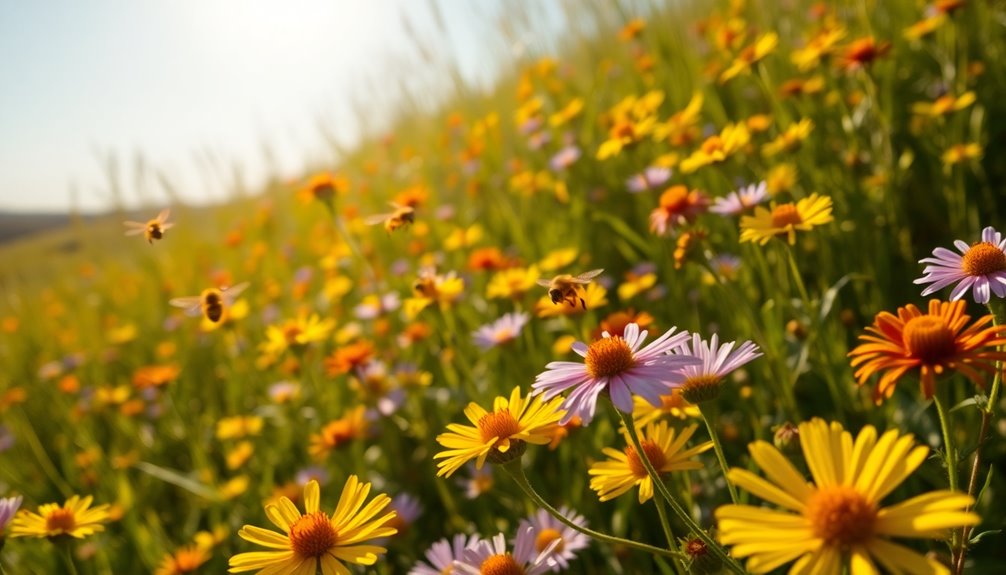
The seasonal foraging patterns of bees reveal a fascinating adaptation to their environment.
You'll notice that honey bees typically kick off their foraging in early spring, as temperatures rise above 16°C (61°F) and floral resources become available. This marks the beginning of their active season.
During late spring and early summer, foraging behavior peaks due to the abundance of floral resources and a surge in colony population. This is when nectar flow is at its highest, allowing bees to collect as much as possible.
As summer progresses into late summer, you'll see a shift; nectar flows diminish, leading to a nectar dearth. This decline can markedly influence foraging behavior and may even result in robbing among colonies as they compete for dwindling resources.
Come fall, bees continue their foraging efforts, gathering nectar to build up honey stores for winter. During this time, brood rearing decreases, and the colony prepares for winter clusters.
Daily Foraging Rhythms

Bees are most active during the day, foraging when temperatures exceed 16°C (61°F) and flowers are in full bloom. Their foraging activity follows a circadian rhythm, peaking in the late morning to early afternoon. This is when the sun is shining, and the nectar is most accessible, allowing bees to gather the resources needed to sustain their honey stores.
During the warmer months, especially in spring and early summer, you'll notice a surge in foraging activity. The abundance of floral resources coincides with the colony's population growth, maximizing the efficiency of their foraging efforts.
As a beekeeper or nature enthusiast, you'll appreciate how these patterns are vital for honey production and colony health.
Interestingly, while most bees stick to daylight foraging, some species may venture out during twilight hours, though this is quite rare. Environmental factors, such as temperature fluctuations, can also impact their daily routines, causing adjustments in foraging times.
Environmental Influences on Foraging

Foraging behavior in honey bees is heavily influenced by environmental factors that dictate when and where they gather resources.
You'll notice that bees typically begin foraging once temperatures exceed 16°C (61°F), which usually happens in early spring. This is when they actively seek out early-blooming plants for nectar and pollen. As spring progresses into late spring and early summer, the abundance of floral resources peaks, and you'll see a significant increase in foraging activity.
Circadian rhythms also play a vital role, with bees primarily foraging during daylight hours. Some species, however, venture out at dawn or dusk, showcasing their adaptability.
But keep in mind that environmental factors, such as weather volatility and temperature fluctuations, can disrupt nectar flow. Such disruptions directly impact their foraging patterns and, ultimately, the health of the colony.
As summer winds down and nectar availability diminishes, you'll observe a decline in foraging activity. This reduction signals a shift in focus as the colony prepares for the colder months ahead, demonstrating just how closely linked their foraging behavior is to environmental changes.
Brood Rearing and Foraging
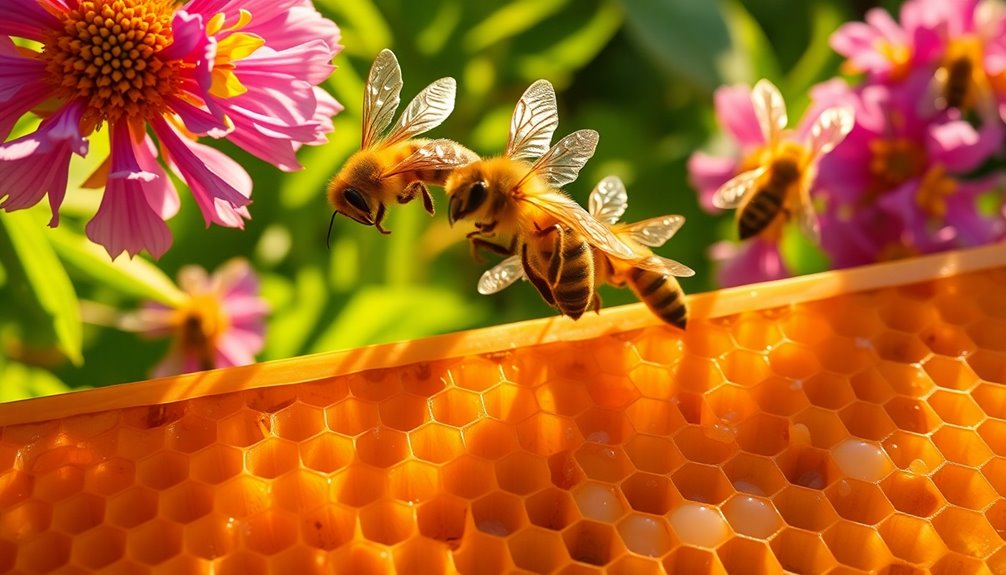
As spring arrives, you'll notice the queen ramping up egg-laying, which drives a surge in foraging activity.
With the increased demand for pollen and nectar, worker bees focus on gathering resources to support brood rearing.
Understanding the timing and resource allocation during this peak period can help you appreciate the intricate balance within the colony.
Brood Rearing Timing
Starting brood rearing in late winter is essential for honey bee colonies, as it signals the queen to resume egg-laying by mid-February when day lengths and temperatures begin to rise.
This timing is important because it directly impacts the colony's growth and survival. As the queen lays eggs, worker bees ramp up their activities to support the developing brood.
Here are three key points about brood rearing timing:
- Spring Peak: Brood rearing peaks in spring, leading to a rapid increase in the worker population. This expansion is crucial for the colony's survival and productivity.
- Foraging Connection: As temperatures exceed 16°C (61°F), worker bees begin foraging for pollen and nectar. This food is essential for meeting the nutritional needs of the growing brood and sustaining the expanding workforce.
- Fall Slowdown: As fall approaches and temperatures drop, brood rearing slows considerably. The diminishing floral resources mean fewer new bees are produced, preparing the colony for winter.
Understanding these rhythms helps you appreciate the delicate balance within a honey bee colony.
Foraging Activity Peaks
During late spring and early summer, honey bee colonies experience their most intense foraging activity, largely driven by the abundance of floral resources. As spring flowers bloom, your colony population swells, thanks to the queen's prolific egg-laying during the brood-rearing peak.
With temperatures rising above 16°C (61°F), the bees keenly venture out to gather nectar and pollen, which are essential for feeding their growing brood. This foraging frenzy is critical for sustaining the nutritional needs of the hive.
However, if you're not monitoring your hive closely, the demands of the brood can lead to resource exhaustion. Providing supplemental feeding can help guarantee that your bees have enough food to continue thriving during this significant period.
The strength of your colony directly impacts its foraging efficiency; healthier, larger colonies can capitalize on the peak blooming periods more effectively.
Resource Allocation Strategies
Resource allocation strategies in honey bee colonies are essential for balancing brood rearing and foraging, especially during peak activity seasons.
As you observe the colony, you'll notice how they adapt their efforts based on environmental cues and resource availability. Here are three key strategies they use:
- Timing of Brood Rearing: In late winter, when temperatures rise, brood rearing begins. The colony ramps up efforts, aligning with the blooming of early flowers to maximize foraging opportunities for honey and pollen.
- Foraging Behavior: As spring progresses, foraging increases considerably. Nurse bees utilize stored honey and pollen to support the growing brood, ensuring they meet the nutritional demands of the colony.
- Resource Optimization: During late summer, when nectar flows dwindle, bees shift focus. They optimize foraging strategies to gather remaining resources, preparing for winter by building up their honey stores.
Nocturnal vs. Diurnal Bees
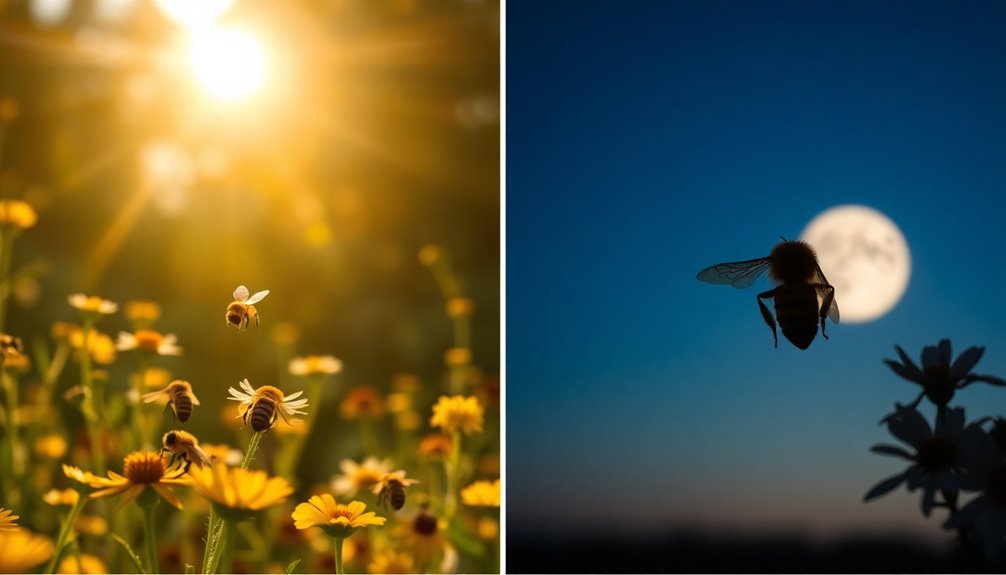
While most bees are active during the day, a fascinating group of nocturnal bees, like the Indian Carpenter bee, operates under the cover of night. Unlike diurnal bees that forage for pollen and nectar in the sunlight, these nighttime pollinators have adapted to low-light conditions. Approximately 250 bee species exhibit this nocturnal behavior, showcasing features like larger ocelli that enhance their light sensitivity.
Nocturnal bees typically forage alone, unlike diurnal bees that thrive in colonies. This solitary approach allows them to navigate their surroundings efficiently, even in complete darkness, as seen with the Indian Carpenter bee. Most nocturnal bees, however, rely on some light, such as moonlight, for navigation.
You'll find these nocturnal species mainly in warmer tropical and subtropical climates, where nighttime temperatures support their activity.
The contrast between nocturnal and diurnal bees highlights the incredible adaptability of these creatures in their quest for pollen and nectar. By understanding their differences, you gain deeper insight into the diverse foraging strategies of bees and the ecological roles they play in various environments.
Adaptations for Nighttime Foraging
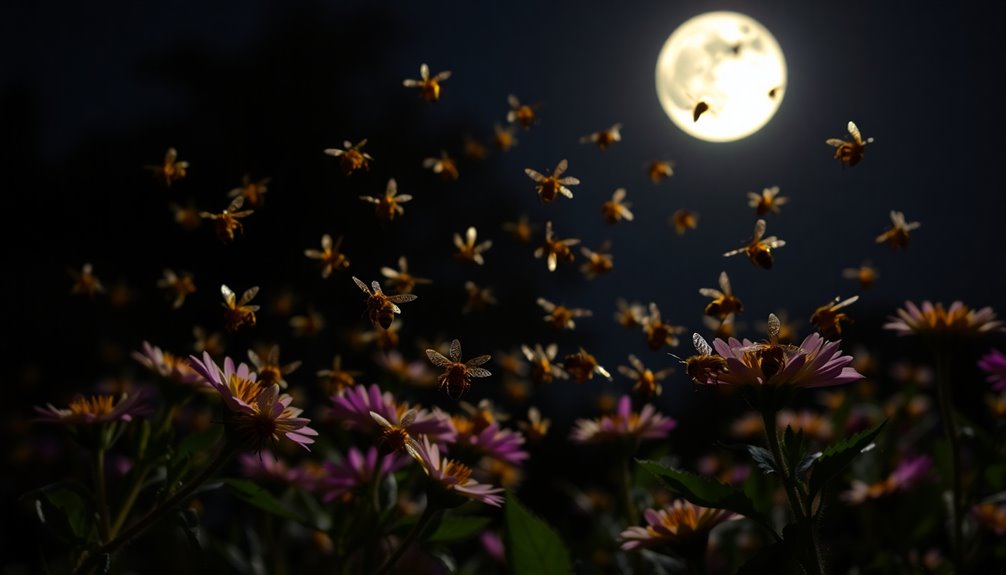
At night, nocturnal bees like the Indian Carpenter bee showcase remarkable adaptations that enable them to thrive in low-light environments.
These adaptations allow them to efficiently forage for nectar while minimizing competition. Here are three essential features that help them succeed:
- Larger Ocelli: Nocturnal bees possess larger ocelli, enhancing their light sensitivity. This adaptation allows them to navigate effectively in darkness and locate floral resources.
- Complex Eyesight: Their eyesight can process polarized light, making it easier to identify flowers even in dim conditions. This skill is vital for finding nectar sources when the moonlight is scarce.
- Solitary Foraging: Unlike diurnal species that work in colonies, nocturnal bees typically forage independently. This solitary behavior reduces competition and enables them to exploit nighttime floral resources.
Impact of Climate on Foraging
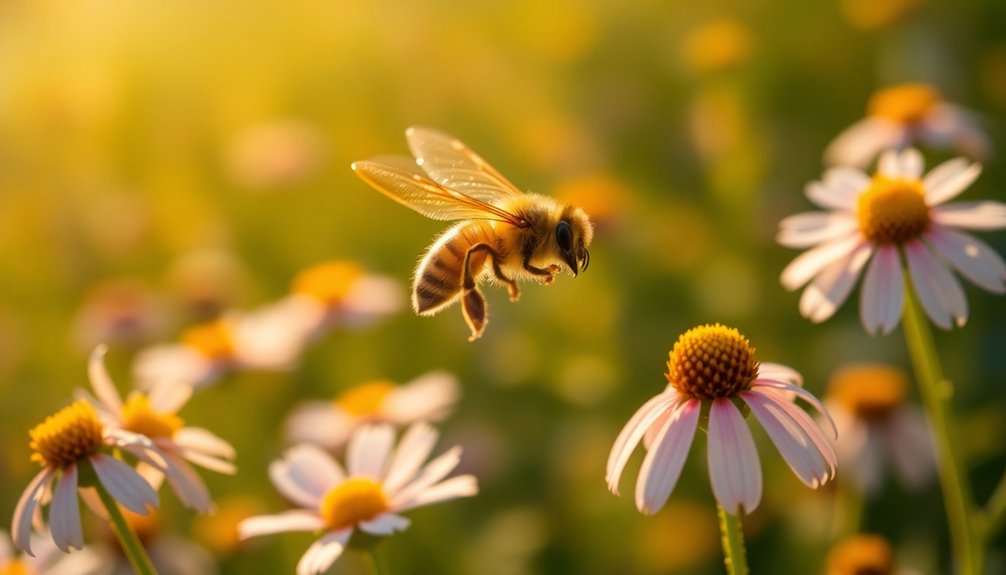
You might be surprised to learn how much temperature affects bee foraging activity.
As the climate changes, bees adjust their schedules to find food, impacting their efficiency and the flowers available each season. This shift can also influence the availability of traditional healing practices, which are often tied to the seasonal cycles of flowering plants used by Aboriginal communities.
Understanding these shifts is essential for appreciating the role of bees in our ecosystem. Additionally, the availability of wild edibles varies with seasonal changes, affecting not only bees but also other foragers in the environment.
Temperature Influence on Activity
Temperature plays an essential role in honey bees' foraging activities, influencing when and how they seek out food. The temperature influence on activity is significant, as bees rely on thermal cues to regulate their foraging behaviors. Research shows that even slight temperature fluctuations can shift their routines by several hours, impacting their efficiency and survival.
Here are three key points regarding temperature's impact on bees:
- Adjustment to Temperature: Over 51% of honey bees adapt their foraging schedules based on temperature changes, highlighting the importance of these cues in their daily rhythms.
- Health Risks: Extreme temperatures can harm honey bee health and reduce their activity, presenting challenges in maintaining colony health during harsh weather.
- Circadian Clocks Disruption: Rising global temperatures threaten honey bee circadian clocks, essential for synchronizing their foraging patterns with floral resources, which may lead to food scarcity.
As temperatures continue to rise due to climate change, it's important to understand how these dynamics affect honey bees, ensuring their survival and the ecosystem's stability.
Seasonal Flower Availability
The interplay between seasonal flower availability and honey bee foraging is fundamental for sustaining healthy colonies. As a beekeeper, you'll notice that honey bees typically ramp up their foraging activities in spring and early summer when flowering plants are abundant. This peak foraging period allows bees to collect critical pollen and nectar, essential for brood rearing and overall colony health.
However, fluctuations in temperature and precipitation can alter the timing and duration of flower blooms. Early-blooming plants like dandelions and crocuses provide crucial resources in late winter and early spring, giving bees a head start as temperatures begin to rise.
During the summer, the diversity of flowering plants, including wildflowers and agricultural crops, supports increased foraging, enabling colonies to build honey stores for winter.
As summer transitions into fall, the availability of nectar diminishes, leading to a decrease in foraging activity. Honey bees then shift their focus toward conserving resources and preparing for winter survival. The health of these bees is also influenced by their surrounding coastal ecosystems, which can provide additional foraging opportunities.
Understanding this relationship between seasonal flower availability and honey bee foraging helps you guarantee your colonies thrive throughout the year.
Weather Variability Effects
As seasonal flower availability influences honey bee foraging, weather variability plays a significant role in determining how effectively bees can gather resources.
Honey bees thrive when temperatures exceed 16°C (61°F), but fluctuations can disrupt their foraging activity. This variability can lead to unpredictable nectar flow, making it challenging for bees to find food.
Consider these key impacts of weather variability on honey bees:
- Temperature Sensitivity: A study showed that 51% of honey bees adjusted their behavior due to temperature changes, highlighting their responsiveness to climate shifts.
- Extreme Weather Events: Heatwaves and cold snaps can negatively affect bee health, resulting in reduced foraging activity and increased mortality rates.
- Seasonal Timing: Weather patterns dictate when bees can forage, with spring and summer being essential seasons for resource gathering due to abundant floral offerings.
Importance of Foraging Behavior

While foraging behavior might seem like a simple task, it plays an essential role in sustaining not just honey bee colonies but also the entire ecosystem. Honey bees are essential pollinators, responsible for pollinating about one-third of the global food supply. Their foraging activities directly enhance crop yield and quality, making them critical for maintaining food resources.
Seasonal changes greatly influence this behavior. During spring and summer, bees are busier collecting nectar and pollen to support brood rearing, as the nutritional demands increase with the growing population. Daily foraging rhythms also come into play, with bees active when temperatures exceed 16°C (61°F) and primarily foraging during daylight hours. Additionally, the presence of gorse plants provides essential nectar sources for bees during winter months.
Here's a visual representation of the importance of foraging behavior:
| Aspect of Foraging | Impact |
|---|---|
| Pollination | Enhances crop yield and quality |
| Nutritional Needs | Supports brood rearing |
| Seasonal Activity | Adjusts based on floral resources |
Understanding these dynamics helps underscore the importance of protecting bee habitats and ensuring their foraging behavior is not disrupted by environmental changes.
Frequently Asked Questions
What Time of Year Do Bees Forage?
Bees forage primarily in spring and summer when temperatures rise and flowers bloom.
You'll notice their activity peak in late spring and early summer, as they collect nectar and pollen to support their growing colonies.
During fall, they gather nectar for honey storage, preparing for winter.
While foraging diminishes in late summer due to fewer flowers, bees remain active as they try to stockpile enough resources for the colder months ahead.
What Months Are Honey Bees Most Active?
You might think bees are active all year round, but they really thrive during specific months.
Honey bees are most active from March to August, when the weather's warm and flowers are abundant. During this period, they forage extensively to gather nectar and pollen.
As summer fades into fall, you'll notice their foraging activity decline, preparing for winter by storing honey and reducing their brood rearing.
At What Age Do Honey Bees Become Foragers?
Honey bees typically start foraging at around three weeks old. At this age, they shift from hive duties to collecting nectar and pollen.
Initially, older worker bees handle foraging, as they've honed their skills. As the colony grows, younger workers take on these roles to meet the increasing nutritional demands of the brood, especially in spring when the queen lays more eggs.
Factors like temperature and daylight also influence when bees begin foraging.
During Which Season Do Bees Collect Most Nectar?
As flowers bloom like a vibrant tapestry in late spring, you'll notice bees buzzing in a frenzy, collecting nectar.
This season, with its warm embrace, becomes their playground, allowing them to gather the sweet sustenance they need.
With each foraging trip, they're not just gathering; they're ensuring their colony thrives.
As summer approaches, their energy shifts toward building food stores, creating a safety net for the colder months ahead.
It's nature's rhythm at work.
Conclusion
In the dance of nature, honey bees swirl through the seasons and hours, each movement perfectly timed to the rhythm of their environment. Understanding their foraging patterns not only highlights their role in our ecosystem but also underscores the delicate balance they maintain with nature. As climate shifts and landscapes change, these tiny pollinators remind us of the interconnectedness of life. By protecting their foraging habits, we can guarantee the music of nature continues to play harmoniously.




